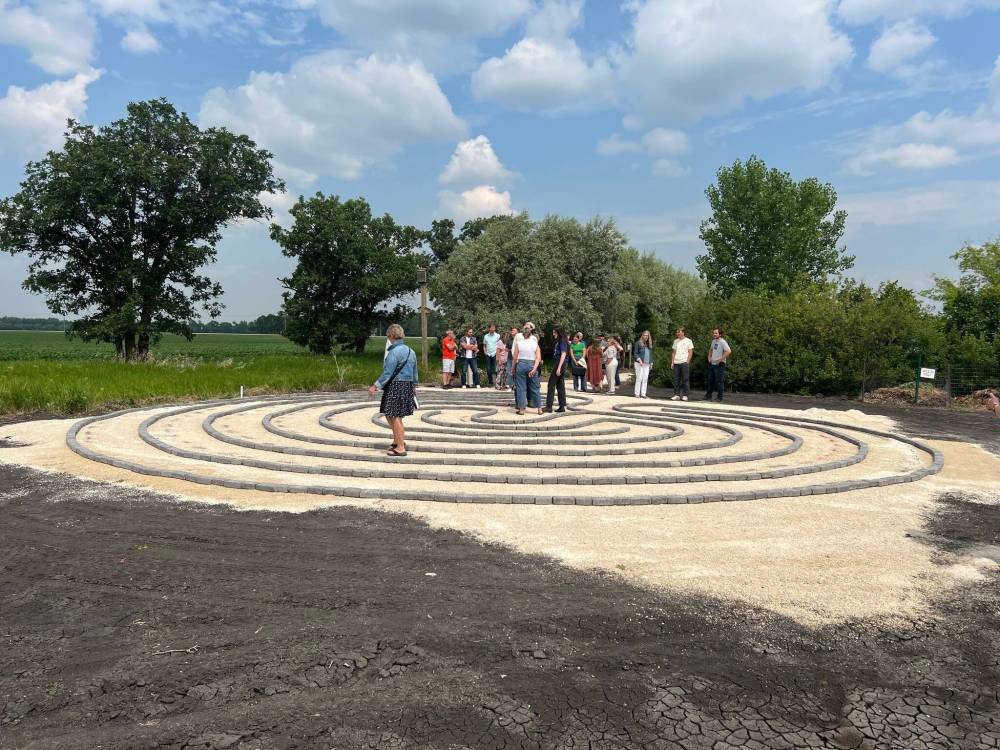New labyrinth offers path to calm, prayer, reflection
Advertisement
Read this article for free:
or
Already have an account? Log in here »
To continue reading, please subscribe:
Monthly Digital Subscription
$1 per week for 24 weeks*
- Enjoy unlimited reading on winnipegfreepress.com
- Read the E-Edition, our digital replica newspaper
- Access News Break, our award-winning app
- Play interactive puzzles
*Billed as $4.00 plus GST every four weeks. After 24 weeks, price increases to the regular rate of $19.00 plus GST every four weeks. Offer available to new and qualified returning subscribers only. Cancel any time.
Monthly Digital Subscription
$4.75/week*
- Enjoy unlimited reading on winnipegfreepress.com
- Read the E-Edition, our digital replica newspaper
- Access News Break, our award-winning app
- Play interactive puzzles
*Billed as $19 plus GST every four weeks. Cancel any time.
To continue reading, please subscribe:
Add Free Press access to your Brandon Sun subscription for only an additional
$1 for the first 4 weeks*
*Your next subscription payment will increase by $1.00 and you will be charged $16.99 plus GST for four weeks. After four weeks, your payment will increase to $23.99 plus GST every four weeks.
Read unlimited articles for free today:
or
Already have an account? Log in here »
RESIDENTS of La Salle who want a place to pray and contemplate, can head to a new labyrinth.
A circular path has been installed on the property of Community Fellowship Church, which is part of the Mennonite Brethren Church of Manitoba, in the town south of Winnipeg.
“Unlike a maze that is built to challenge people to find their way through it, a labyrinth has a single path to the centre and back,” said church member Randall Holm, the brainchild behind the labyrinth.

Randall Holm photo
The La Salle labyrinth adds to a rich local tradition, joining contemplative paths at Fort Garry United, St. Peter’s Anglican, HSC and King’s Park.
With its twists and turns, a maze represents the challenges and experiences people encounter in life, he explained, while a labyrinth enables people to walk an easy-to-follow path.
While walking, the goal is to quiet the soul while praying, meditating or just being silent. Pre-written prayers are available for those who want guidance.
“It is intended to replicate the spiritual journey,” Holm said. “We may not know where that takes us, only that we will arrive at the centre. It is a walking prayer. As a circle, it is a universal symbol of peace, unity and wholeness.”
Holm came up with the idea when the church invited members to suggest ways it could be more inviting to the community.
“We already have a community garden that is open to the whole community, so I thought, why not a labyrinth, too? It has a deep history in Christianity as a way to help people calm themselves, pray and reflect.”
While labyrinths predate Christianity, being found in places like ancient Egypt and India, they were adapted and adopted by the church as a symbol of the spiritual journey toward salvation, like a pilgrimage toward God.
Labyrinths really flourished in the 12th and 13th centuries, with some famous ones installed in places like the Chartres Cathedral in France — where it still exists today. Pilgrims who could not travel to the Holy Land walked the labyrinth instead, calling it a “pilgrimage in miniature.”
Labyrinths fell out of favour in Protestant churches following the 16th century Reformation, because of their connection to Roman Catholicism and due to the Reformation emphasis on Bible reading and preaching. Many labyrinths were destroyed or covered over.
In Winnipeg today, labyrinths can be found indoors at Fort Garry United Church and St. Peter’s Anglican Church in River Heights. They can also be found at the Health Sciences Centre and at the Carol Shields Memorial in King’s Park.
The labyrinth in La Salle is outdoors, made of packed gravel with bricks to create the winding 25-metre long path.
“It took 20 yards of limestone and 1,600 linear feet of bricks,” said Holm, adding the cost was over $3,000.
The work itself was done by volunteers from the church, who tilled and prepared the soil, laid out the path and packed it down.
Eventually, trees and bushes will be planted around the labyrinth, and in the centre will be what Holm called a “tree of hope.”
“When people make it to the centre and our tree of hope, we invite them to pray for global peace and a sustainable environment,” he said, adding the labyrinth isn’t a recruiting tool for the church. “Everyone is welcome to use it.”
Church pastor Kevin Dyck said the labyrinth is a bit “outside the box” for a Mennonite Brethren church, but the feature is a new way to serve the community.
“I love that we can use our property in this way,” he said. “Between the community garden and the labyrinth, it’s a nice balance.”
faith@freepress.mb.ca
The Free Press is committed to covering faith in Manitoba. If you appreciate that coverage, help us do more! Your contribution of $10, $25 or more will allow us to deepen our reporting about faith in the province. Thanks! BECOME A FAITH JOURNALISM SUPPORTER

John Longhurst has been writing for Winnipeg's faith pages since 2003. He also writes for Religion News Service in the U.S., and blogs about the media, marketing and communications at Making the News.
Our newsroom depends on a growing audience of readers to power our journalism. If you are not a paid reader, please consider becoming a subscriber.
Our newsroom depends on its audience of readers to power our journalism. Thank you for your support.
The Free Press acknowledges the financial support it receives from members of the city’s faith community, which makes our coverage of religion possible.

